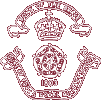


 |
 |
|
 |
||
| Navigation links at the bottom of this page |
| How Morris sees red |
Does 'like a red rag to a bull' mean raging bulls react to the colour or the movement of the rag? An interesting question; or again, does a robin attack another robin invading its territory in reaction to its colour or the movement of colour? What about a stickleback in an aquarium tank that goes berserk when it sees red outside the glass? Red is the colour of danger because, perhaps, it is the dominant colour and commands attention. The colour red affects more than bulls and robins and sticklebacks. It changes the eye's perception of other colours and combinations. The scarlet coat of the British soldier in the 18th and 19th centuries is a particular hue or tint of red, which most canvas artists had difficulty reproducing. Philip R. Morris, who did the masterful Sons of the Brave painting, was one of the few who did get it right, but only after much trial and error. His achievement was recognized when the Royal Academy exhibited his painting at the 1880 exhibition. This was revealed in the catalogue The Academy catalogue dated 20 May 1880 p. 407. |
At the Royal Academy exhibition of 1880, the only picture of a contemporary military scene was Philip Morris's parade of cadets entitled The Sons of the Brave , which produced the following interesting comment: "We have heard more than once of the impossibility of finding a satisfactory presentment of the scarlet coat of the British soldier, and it must, indeed, be allowed that the subject has been the occasion of much disastrous failure." |
Although somewhat obscure, the meaning of this statement is that the scarlet of the redcoat was difficult to portray; artists had difficulty getting the right shade and tone of red. On the subject of tone and hue, in his book The Approach to painting (1947), Thomas Bodkin wrote that: |
"... colours are amazingly susceptible to their surrounding. The juxtaposition of two colours causes each to lose whatever they may have in common. Thus red mixed with yellow makes orange, and yellow with blue makes green, and blue with red makes violet, yellow set beside blue takes on an orange tint and gives the blue a violet tint, both yellow and blue in juxtaposition seeming to have absorbed a tinge of red. Sound knowledge of these mysterious changes emboldened Delacroix to boast 'With mud I can paint you the skin of Venus provided you let me surround it as I will.' The good colourist never applies a touch of colour to his canvas without considering what its effect will be on the colours already there. One ill-considered touch may change the whole aspect of his picture. Suppose a painter to have painted a forest scene, and to have lavished on it all the resources of his palette, greens in hundreds of hues and shades. The result will look dull until he enlivens all those greens with some spot of complimentary colour. The crude artist may introduce a little figure with a red coat, and immediately all the greens take on a new life. It gleams and sparkles. But the little figure itself will be obtrusive. It makes too harsh a contrast. The subtle artist will more likely insert a touch of orange, which will effectively give character to the green and be less distracting. |
It is difficult to add to what Bodkin wrote about the use and effect of one colour on another or a single colour to a painting, but there is no need. He says it all. One only needs to illustrate Bodkin's point, particularly with respect to the achievement of Morris with his Sons of the Brave canvas. Without repeating the comparison of the reds in the two Sons of the Brave versions discussed in the 1880 Artist at work article, here are paintings that illustrate the effect various tones of red bring to the canvasses in which they are used. |
The spatial quality of the draughtsmanship of the image provides a magnificent, proportional aspect of each figure in position at the top of the steps leading from the main entrance. Those proportions, of boys to adults to the massive columns are in perfect symmetry. The canvas is more than a two dimensional picture of the scene, for the artist has captured the movement and frozen it in the mind's eye. Its beauty of composition. in no manner photographic, is in the eye of the beholder for whom Morris, with the magic of his brush and palette, has produced a scene that radiates to perfection. It is an image that, once seen, will never be forgotten. It is no wonder that it made such a strong impression to the general public when it was exhibited in 1880. With this reminder and interpretation of the artist's genius, look at Morris's Sons of the Brave painting again and marvel at his accomplishment. It is truly a work of art. |
| ||||||||||
|
© A. W. Cockerill 2011 Site Map Contact me | ||||||||||